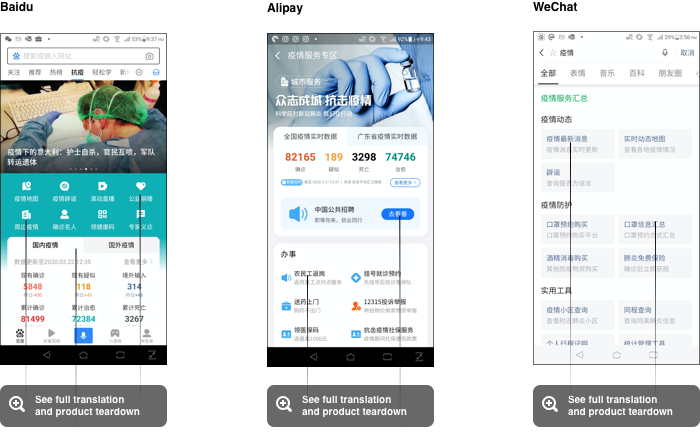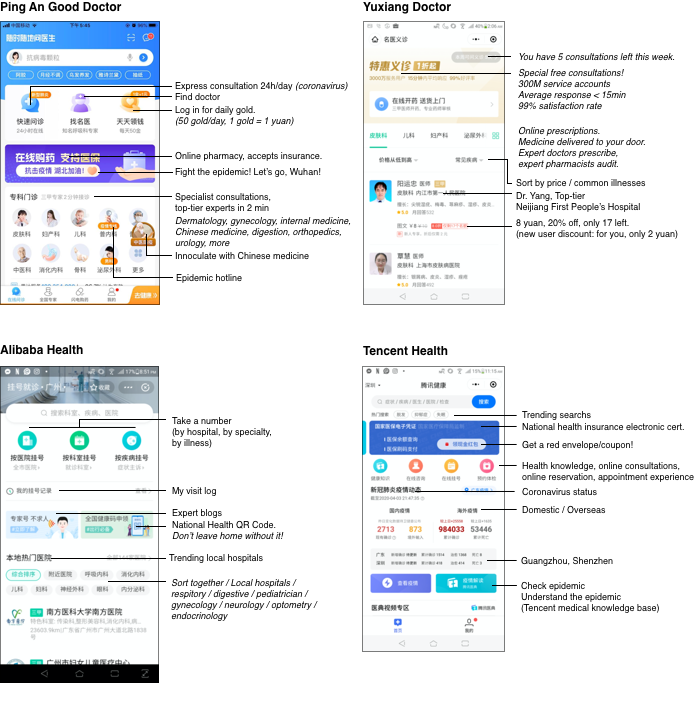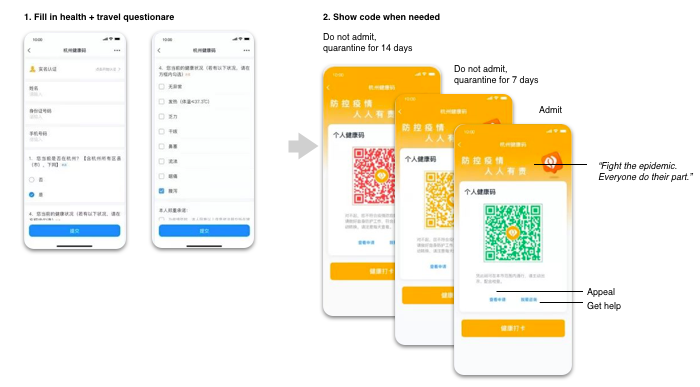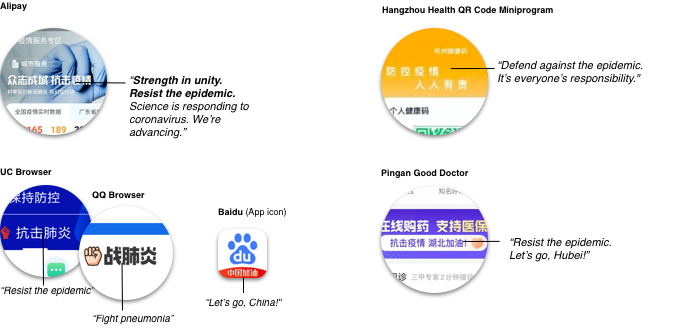How Chinese Apps Handled Covid-19

Summary: China’s apps played a pivotal role in supporting some of the most effective tactics the country used in fighting Covid-19, including the use of fever clinics and the strict quarantining of individuals based on their risk level. Apps there exposed a plethora of tools to keep people healthy, well-stocked, and at-ease during the crisis. Chinese tech companies’ swift response was not only in service of public good, but also of their private agendas, to compete with each other and create new habits and sources of lock-in. Here in Silicon Valley, this should invite reflection on what more we can do.
I used to blog a lot about product design in China, but since moving back to the US, I’ve relinquished myself to being a mere spectator, as my first-hand knowledge became outdated.
But as I’ve sat quarantined the past month and followed the story through Chinese apps and media, I realized it was so damned interesting that I couldn’t not share it. And besides, there’s nothing on Netflix.
PSAs, Info Centers, and Tools
Every major Chinese app has added dedicated hubs for the Coronavirus. They’ve all smoothly integrated tons of different tools to help people get through the crisis, including:
- Statistics: Apps scraped the figures from the National Health Commission reformatted, resliced, and visualized in it in myriad ways.1
- Check Your Exposure: Multiple tools let people check whether other passengers of specific planes and trains they’d been on had been diagnosed (this information aggregated by the State Council). Independently-developed let people even check individual apartment blocks.
- E-Medicine: Maps directing people to the nearest fever clinics and ICUs. Online consultations and perscriptions, as well as psychogical counseling.
- E-Commerce: Masks, hand sanitizer, and more, through each app’s preferred partners. Additional tools let users check the quality of a mask given its serial number, view the quantities of masks at stores near them, and report price gouging.
- Tools for Quarantine: Before Health QR Codes (described below) launched, other tools helped individual communities take roll calls and keep records.
As interesting as the array of services on offer is, equally interesting is the way app developers decided to surface them in their apps. But to save you all the inside baseball, you can see these details by clicking into the screenshots below:

Yes, there’s certainly a lot going on here, and we could go on forever looking at each of these features.
The two worth examining more closely are how apps helped people get care and the rise of Health QR Codes.
Getting Care
In a New York Times interview, the WHO’s Bruce Aylward pointed out a few distinctive features of the Chinese response to Covid-19, including the use of online medicine and fever clinics:
How did the Chinese reorganize their medical response?
First, they moved 50 percent of all medical care online so people didn’t come in. Have you ever tried to reach your doctor on Friday night? Instead, you contacted one online. If you needed prescriptions like insulin or heart medications, they could prescribe and deliver it.
But if you thought you had coronavirus?
You would be sent to a fever clinic. They would take your temperature, your symptoms, medical history, ask where you’d traveled, your contact with anyone infected. They’d whip you through a CT scan …
The point of these “fever clinics” (发热门诊), as distinguished from ordinary hospitals, was to give anyone who thought they might be even a little sick2 a way to get tested and, more importantly, control the spread by isolating even asymptomatic carriers away from their family and co-workers and give them a place to wait it out. Some of these had been established for this reason on a permanent basis during the SARS outbreak in 2003, while others were established only recently.
As the country mobilized, all of the major apps promoted features that clearly listed the hospitals that were handling Coronavirus. This included all the fever clinics that had sprung up as well as normal, pre-existing hospitals with ICUs that had been specially designated for handling serious cases of coronavirus (定点收治医院):
The other aspect Aylward mentions is the use of online consultations. Changes in regulations in the past few years have resulted in an explosion of telemedicine apps in China with plays by tech companies like Tencent and Alibaba, traditional companies like Ping An, and existing online medical information resource sites like Dingxiang.
These apps combine a bunch of things: simple ecommerce (for medicine and medical devices), lead generation/vertical search for specialists offline, and online consultations with doctors at top hospitals. Doctors giving online consultations can write prescriptions which can then be filled in the app. The consultations can be paid for a-la-carte or with an annual plan and are sometimes a loss-leader for their online pharmacy business. (This episode of the PanDaily podcast offers a good deep dive into the underlying business models.)
This glut of telemedicine apps affected the outbreak by reducing load on hospitals for non-coronavirus matters, as well as being an appealing first step for those who would otherwise fear catching the virus for sure by going to a hospital. During the crisis, these apps competed to launch new features, offered discounts, issued bombastic press releases, and saw huge surges in usage. They were also prominently integrated into major apps as mini-programs and promoted with other coronavirus-related features.
Ping An saw a 10X increase in new user signups and a 9X increase in online consultations during this period. Dingxiang saw a 2X increase in consultations. According to them, these consultations largely were around whether the patient’s symptoms indicated coronavirus, whether they were wearing their mask correctly, and common concerns like rashes, common colds, infected wounds, allergies, and pinkeye.
Health QR Codes: from Hangzhou to every zhou
The most aggressive action taken early on in China’s management of the crisis was the full lockdown of Wuhan and other cities in Hubei. But across the rest of the country, as in the US, individual provinces and cities enacted their own measures, juggling both public health and economic needs.
Security guards at offices and apartment complexes came up with their own schemes to compel sick people to quarantine. This involved doing temperature checks and asking people about their health and travel history before being allowed into offices, stores, and public transit. To help with this, the phone companies provided a service to offer proof of travel history(个人行程证明) based on location data, in case it was called into question during the grilling.
Some particularly zealous communities created group chats with every resident and asked everyone to report their health each day (which is, um, the kind of personal thing I wouldn’t want to share in a group chat). Many issued paper passes authorizing residents to leave (出入证). Tencent’s community management app Haina offered an electronic version to apartment complexes free to promote the product.
With waning numbers of new cases outside of heavily-locked-down Hubei, there was mounting desire to return to work in many cities. The Hangzhou munincipal government issued guidelines to companies on how to gradually re-open, with different zones of the city on a schedule.
Unlike other cities passing similar policies at the time, they also established a digital platform for reporting workers’ health and gradually whitelisting more enterprises to re-open. Naturally, the system could only be accessed via Alipay and Dingtalk (Alibaba is based in Hangzhou). Central to the system was the notion of a personal health QR code:
To get a code, you fill out a health questionaire (which is linked to your real identity via national ID card). Your code is either red, yellow, or green. If you’re green, you’re admitted, otherwise, you’re refused and reminded to quarantine. The code can be scanned by guards to verify that it is indeed yours.
This was a huge improvement over the then-status-quo of paperwork, passbooks, ID cards, and nosy building managers pestering everyone via WeChat to report their health. The Hangzhou Health Code system received 10M hits on just the first day after launch.
But this new solution came with problems of its own. Some found their codes inexplicably change from green to red during the day, and others found themselves locked out of their apartment complex. Questions mounted: how are children, the elderly, and other people who don’t use Alipay supposed to use this? What about foreigners and people from Hong Kong, Macau, and Taiwan? “Yeah, we know,” the city government replied, “it’s a 1.0. We’re working on it.”
The actual algorithm to decide which risk category one falls into is a topic of speculation, though it seems it was largely a combination of the information in the questionaire, how long someone has waited since getting the code, and the locations the code is later scanned in (along with the public health situation in those locations).
Health QR codes soon swept the country, with other cities and provinces quickly launching their own versions. Alibaba’s tech powered some of these regional systems (they claim 200). Other regions turned to Tencent, who also threw in the ring, eventually launching 300 systems that generated over 1B codes for 800M unique users (go figure). With the handwavy grandiloquence that always seems to accompany enterprise software, Tencent would herald their take on the idea as a “Great Wall of Data” and submit a proposal for ratification as an official industry standard.3
On March 4th, an editorial by Hu Jiefei in Xinhua lamented this fractured state of affairs:
According to incomplete data, there are nearly 100 types of health QR codes issued by provinces and cities nationwide…The launch of health QR codes was aimed at making the resumption of work more precise, scientific, and orderly. But in practice, they’ve actually become a barrier. If you want to make Health QR Codes more effective at this, they need to be smoother in every aspect.
First of all, they need to be able to connect to more types of data. Take, for instance, Shanghai’s “Suishen Ma”: it relies on the Shanghai Big Data Platform, aggregating data from the public health office, police, transportation, and other city departments, as well as telecom, aviation, and railroad data.…
Second, the system needs to interoperate between regions. Public health is a complex system – no region is an island unto itself. With the resumption of work proceeding so quickly, and so many people traveling, the obstacles caused by lack of coordination between regions ought to be considered in making policy.
The good news is that many regions have agreed to recognize Health QR codes from other regions. The Yangtze River Delta, Beijing, Tianjin and Hebei have announced a mutual recognition agreement, as have Zhejiang, Shandong, and Guizhou.
Sure enough, as often happens after an op-ed from the state press agency complains that the national government really ought to get around to doing something about a problem, the national government did something.
On March 20th, the State Council launched its own national health QR code simultaneously on multiple platforms: via their iOS and Android apps, as a WeChat mini-program, and as an Ali mini-program (see sidebar for more on mini-programs). As a 1.0, it still lacks many of the refinements made in the prior month by some of the regional versions.
We Can Do More: Apps and Pixel Power
To flatten the curve of armchair epidimiology, I should recognize, as a tech guy, I’m clearly not qualified to speculate as to which country’s systems better handled this epidemic. Much is still unknown about the virus itself, the numbers behind it. And political intrigue still abounds in the halls of the White House, Zhonghanhai, and the WHO.
But as someone who’s built apps in both countries, and viewing this crisis narrowly through the lens of apps, there’s no contest4. I mean, really. What has Silicon Valley done so far? We’ve added some PSAs to our apps with links to the CDC and WHO, throw in some news and some cutesy clipart:
And remember the other week? When Trump triumphantly announced that Google would have an app to direct people to testing centers by the following week, and they had to clarify: “Well, it’s really a subsidary of ours, and it’s a beta, for some areas, and not for a while.” Come on. This is our response?
Should the American tech industry try to launch solutions more like the ones in China? Wouldn’t it be cool if these UIs in our apps had a kajillion buttons with stuff you can actually do about the coronavirus?
No, that sort of thinking never works. We’ve got completely different problems in the US, which need different solutions. The most pressing ones seem to be that community spread is still rampant in states that haven’t closed schools or issued curfews, people don’t want to or aren’t able to wear masks, and there still aren’t enough tests. These are largely political problems, not really ones that can be addressed through apps. So for tech to help, we might need to get political.
By now, we’ve heard complaints from every side about the “politicization” of the epidemic. Yet we’ve heard leaders around the world compare it to a war, and wars are anything if not political. You can’t talk about something this big without bumping into its politics.
Similarly, recent events seen through the lens of apps show that we can no longer talk about software without talking about politics. (I’ve never gone into it before in all my posts on software design in China because there was always plenty to talk about without it).

Historial events have been inextricably tied to the medium the public experiences them through – whether that be newsreels and photos in the world wars, the election of 1960 through the first televised debates, or the Gulf War as experienced in the then-new 24-hour TV news cycle. This moment in history is one that will be linked in our memories to our phones and our apps, if only for no other reason than because we’re all stuck in our homes with nothing to do but twitch and check our apps. Apps have an untapped political power.
Chinese apps haven’t been quite as shy about using this power. For one thing, look at the language used in these UIs:
Well, the word choice is certainly very…collectivist. They’re also, what we’d call in America, fightin’ words. By comparison, the content Google shows is afraid to recommend sheltering in place or wearing masks for fear of offending.
Consider, too, how apps have treated the statistics around the epidemic. Yes, there’s some doubt in these figures. But there’s no denying Chinese apps have made deliberate design choices in making statistics front-and-center, and in selecting the specific breakdowns displayed5. The recent change in these UIs to separately break out the number of domestic cases imported from abroad is propogandistic. It supports the narrative, correct or not, that China’s largely cracked this thing and it’s those pesky foreigners who are bringing it back in.
At just about every juncture, the politics of this story played out through China’s apps. When the government built two temporary hospitals in Wuhan, they hammed it up by offering 24/7 livestreams of construction. 40 million extremely bored people tuned in and ended up giving nicknames to the forklifts6. When profuse outrage over Dr. Li Wenliang’s death on social media proved no match for censors, the state media reacted by memorializing him as a martyr, complete with a series of mobile-optimized, equally meme-worthy images. And most recently, every major app and site changed to a grayscale color palette for a national day of mourning.7
American apps should consider making their own similarly opinionated or even propogandistic choices in their product design. But because it’s a free country, it’s really up to them on how to do this.
They could start by putting stats front-and-center on their homepages and highlighting the number of tests performed, which seems to be the piece we’re having trouble with here. Tristan Harris explores this idea further. If someone gets directions to a restaurant or a church, apps could remind them to social distance – despite what some governors might say.
Since the post-2016 “techlash”, tech companies in Silicon Valley have acted with a sometimes suffocating sense of caution and unease about their power in the world. They are extremely careful to not do anything that would set off either party or anyone with ideas about regulation. And they seldom use their pixel real estate towards affecting political change (unless in the rare case where the political action being advocated for is one that benefits them).
Yes, it seems apps these days are afraid of politicians. And you can see how well that’s worked out for us.
If big tech ends up making a real difference in this fight, an unavoidable consequence will be politicans becoming afraid of apps.
Maybe then, the next time something like this comes along, our politicians will do a better job.
ACKNOWLEDGEMENTS
Thanks to Rui Ma, Roger Zurawicki, Tori Zhao, Chongwei Liu, and Alistair Thornton for reviewing drafts of this article.
FOOTNOTES
-
This article is a great teardown of the data tools released during the epidemic from a product perspective. And if you want to try something like this, there are worse places to start than Tencent’s open source code. ↩
-
A cultural quirk I never quite understood when I lived in China was how when my friends and colleagues got even the slightest cold, rather than chugging DayQuil and Red Bull as I would, would take an hour off work to see a doctor in person. ↩
-
The actual proposal submitted to the Shenzhen Standards Promotion Council contains no real, concrete technical detail and is instead a rather vacuous, high level description of the system archicture and usecases. ↩
-
This is not necessarily the result of top-down nationalist pressure, as we’re often so quick to assume in any story about China, but self interest as well. Every growth-thirsty product manager in China eager to meet their KPIs, I’m sure, was dying to find a way to shoehorn these stats into their feature to boost engagement. ↩
-
If this played out in America, “Forky McForklift” would be an inevitability. ↩
-
Chinese apps are always flamboyantly re-skinning their entire UI for holidays, whether that’s going red for Lunar New Year or going full-on-Geocities for Christmas. So I suppose this is the least they could do. ↩






